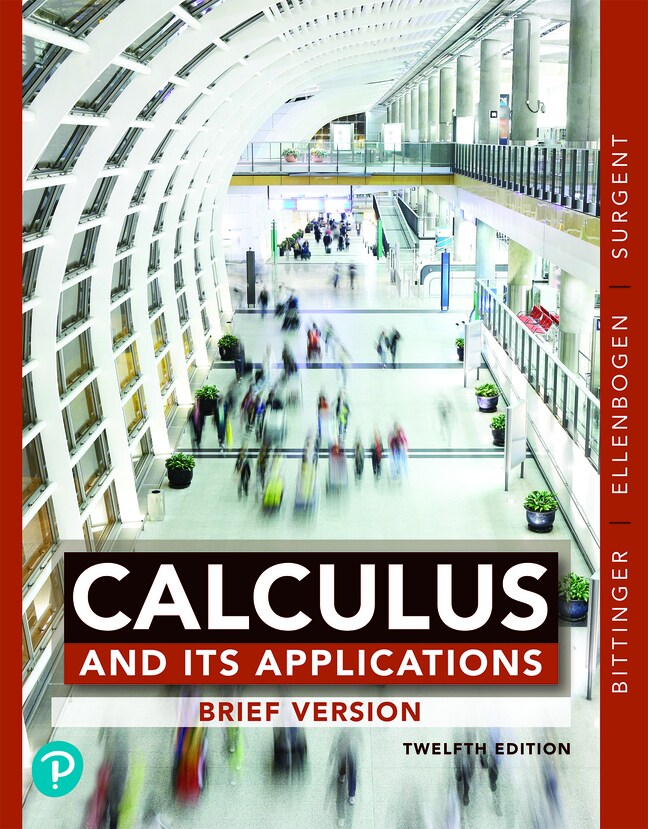
Calculus and Its Applications, Brief Version, 12th edition
- Marvin L. Bittinger
- , David J. Ellenbogen
- , Scott A. Surgent
- , Gene Kramer

- Watch and learn
Videos & animations bring concepts to life
- Listen on the go
Learn how you like with full eTextbook audio
- Find it fast
Quickly navigate your eTextbook with search
- Stay organized
Access all your eTextbooks in one place
- Easily continue access
Keep learning with auto-renew
Calculus and Its Applications, Brief Version is known for an approach that anticipates and meets students' needs, pairing clear explanations with carefully crafted figures to help you visualize concepts. Key revisions in the 12th Edition include the earlier introduction of logarithmic and exponential functions to help you master these important functions and their applications. New co-author Gene Kramer revisited every homework question and learning aid to improve clarity and accuracy. All aspects of this revision aim to motivate and help you understand and apply calculus principles more readily.
Published by Pearson (July 15th 2020) - Copyright © 2020
ISBN-13: 9780136880257
Subject: Finite Math & Applied Calculus
Category: Applied Calculus
- Preface
- Prerequisite Skills Diagnostic Test
R. Functions, Graphs, and Models
- R.1 Graphs and Equations
- R.2 Functions and Models
- R.3 Finding Domain and Range
- R.4 Slope and Linear Functions
- R.5 Nonlinear Functions and Models
- R.6 Exponential and Logarithmic Functions
- R.7 Mathematical Modeling and Curve Fitting
- Chapter Summary
- Chapter Review Exercises
- Chapter Test
- Extended Technology Application: Average Price of a Movie Ticket
1. Differentiation
- 1.1 Limits: A Numerical and Graphical Approach
- 1.2 Algebraic Limits and Continuity
- 1.3 Average Rates of Change
- 1.4 Differentiation Using Limits and Difference Quotients
- 1.5 Leibniz Notation and the Power and Sum—Difference Rules
- 1.6 The Product and Quotient Rules
- 1.7 The Chain Rule
- 1.8 Higher-Order Derivatives
- Chapter Summary
- Chapter Review Exercises
- Chapter Test
- Extended Technology Application: Path of a Baseball: The Tale of the Tape
2. Exponential and Logarithmic Functions
- 2.1 Exponential and Logarithmic Functions of the Natural Base, e
- 2.2 Derivatives of Exponential (Base-e) Functions
- 2.3 Derivatives of Natural Logarithmic Functions
- 2.4 Applications: Uninhibited and Limited Growth Models
- 2.5 Applications: Exponential Decay
- 2.6 The Derivatives of ax and logax
- Chapter Summary
- Chapter Review Exercises
- Chapter Test
- Extended Technology Application: The Business of Motion Picture Revenue and DVD Release
3. Applications of Differentiation
- 3.1 Using First Derivatives to Classify Maximum and Minimum Values and Sketch Graphs
- 3.2 Using Second Derivatives to Classify Maximum and Minimum Values and Sketch Graphs
- 3.3 Graph Sketching: Asymptotes and Rational Functions
- 3.4 Optimization: Finding Absolute Maximum and Minimum Values
- 3.5 Optimization: Business, Economics, and General Applications
- 3.6 Marginals, Differentials, and Linearization
- 3.7 Elasticity of Demand
- 3.8 Implicit Differentiation and Logarithmic Differentiation
- 3.9 Related Rates
- Chapter Summary
- Chapter Review Exercises
- Chapter Test
- Extended Technology Application: Maximum Sustainable Harvest
4. Integration
- 4.1 Antidifferentiation
- 4.2 Antiderivatives as Areas
- 4.3 Area and Definite Integrals
- 4.4 Properties of Definite Integrals: Additive Property, Average Value, and Moving Average
- 4.5 Integration Techniques: Substitution
- 4.6 Integration Techniques: Integration by Parts
- 4.7 Numerical Integration
- Chapter Summary
- Chapter Review Exercises
- Chapter Test
- Extended Technology Application: Business and Economics: Distribution of Wealth
5. Applications of Integration
- 5.1 Consumer and Producer Surplus; Price Floors, Price Ceilings, and Deadweight Loss
- 5.2 Integrating Growth and Decay Models
- 5.3 Improper Integrals
- 5.4 Probability
- 5.5 Probability: Expected Value; the Normal Distribution
- 5.6 Volume
- 5.7 Differential Equations
- Chapter Summary
- Chapter Review Exercises
- Chapter Test
- Extended Technology Application: Curve Fitting and Volumes of Containers
6. Functions of Several Variables
- 6.1 Functions of Several Variables
- 6.2 Partial Derivatives
- 6.3 Maximum - Minimum Problems
- 6.4 An Application: The Least-Squares Technique
- 6.5 Constrained Optimization: Lagrange Multipliers and the Extreme-Value Theorem
- 6.6 Double Integrals
- Chapter Summary
- Chapter Review Exercises
- Chapter Test
- Extended Technology Application: Minimizing Employees’ Travel Time in a Building
- Cumulative Review
Appendices
- A. Review of Basic Algebra
- B. Indeterminate Forms and l’Hôpital’s Rule
- C. Regression and Microsoft Excel
- D. Areas for a Standard Normal Distribution
- E. Using Tables of Integration Formulas